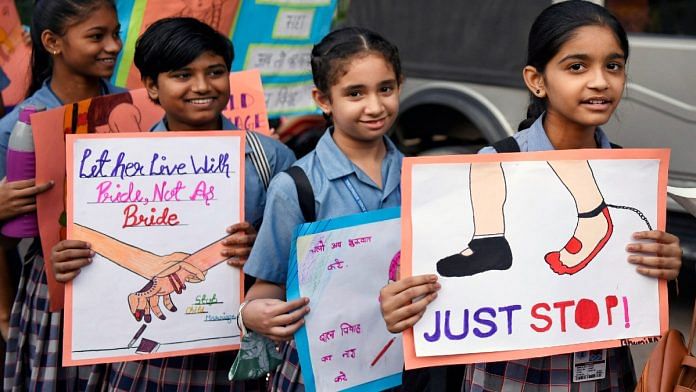Thank you dear subscribers, we are overwhelmed with your response.
Your Turn is a unique section from ThePrint featuring points of view from its subscribers. If you are a subscriber, have a point of view, please send it to us. If not, do subscribe here: https://theprint.in/subscribe/
The National Legal Services Authority’s (NALSA) Standard Operating Procedure (SOP) to eliminate child marriages, formulated in compliance with the Supreme Court’s landmark judgment in Independent Thought v. Union of India (2017) and subsequent directives in Society of Enlightenment and Voluntary Action v. Union of India (2024), marks a critical step toward addressing one of India’s most persistent social evils. The SOP, titled Towards Eliminating Child Marriage, 2025, adopts a multipronged strategy combining legal enforcement, institutional coordination, and community empowerment.
However, its success hinges on overcoming systemic challenges, including deep-rooted cultural norms, bureaucratic inefficiencies, and gaps in implementation.
Child marriage remains widespread in India, with UNICEF’s 2023 report estimating that 23% of women aged 20–24 were married before age of 18, peaking at 40% in states like Bihar and West Bengal. The practice perpetuates cycles of poverty, gender inequality, and health risks, including higher maternal mortality and limited educational opportunities for girls. The Supreme Court’s intervention in Independent Thought recognized child marriage as a violation of fundamental rights, particularly emphasizing its disproportionate impact on girls. The 2024 judgment further mandated NALSA to devise a robust framework for prevention, protection, and rehabilitation, culminating in this SOP.
The SOP’s strength lies in its structured institutional mechanism—the ASHA (Awareness, Support, Help, and Action) unit—which brings together judicial officers, district administrators, law enforcement, and civil society under one umbrella. By integrating stakeholders like the Child Welfare Police Officer, District Child Protection Officer, and healthcare providers, the framework ensures a coordinated response. For instance, the ASHA unit is tasked with immediate complaint redressal through the Bal Vivah Mukt Bharat Portal, annual intervention plans, and mandatory reporting by government servants. This aligns with the Supreme Court’s emphasis on accountability and inter-agency collaboration.
The SOP prioritizes prevention through legal awareness campaigns, helpline dissemination (1098), and community engagement. It mandates panel lawyers and para-legal volunteers to assist victims in obtaining protection orders and injunctions under the Prohibition of Child Marriage Act (PCMA), 2006. Notably, it addresses the intersection of child marriage and reproductive rights by providing legal support for pregnancy termination, ensuring confidentiality and adherence to medical termination laws. The inclusion of vocational training and skill development programs reflects a recognition of economic drivers behind early marriages.
Rehabilitation measures include shelter home referrals, mental health counseling, and family foster care under Mission Vatsalya. The SOP’s focus on children born from child marriages—by appointing counsellors for those above three years—acknowledges the intergenerational impact of the practice. However, the success of these initiatives depends on the availability of trained personnel and funding, particularly in rural areas where child marriage rates are highest.
While the SOP is comprehensive, its implementation faces hurdles. First, the ASHA unit’s effectiveness relies on the proactive involvement of district-level officials, who may lack training or incentives to prioritize child marriage cases. Second, cultural resistance in communities where early marriage is normalized could undermine awareness campaigns. For example, the UNICEF report notes stark disparities between states, with Lakshadweep reporting only 1% child marriages compared to Bihar’s 40%. Tailored strategies for high-prevalence regions are essential. Third, the SOP’s reliance on digital tools like the Bal Vivah Mukt Bharat Portal may exclude marginalized groups with limited internet access.
The SOP aligns with broader legal reforms, including the PCMA and Juvenile Justice Act, but gaps persist. For instance, the PCMA’s ambiguous penalties and reliance on child marriage prohibition officers (CMPOs)—often overburdened and under-resourced—weaken enforcement. The SOP’s directive to involve CMPOs in rehabilitation is commendable but requires bolstering their capacity. Additionally, the Supreme Court’s 2024 judgment emphasized the need for “long-term rehabilitation plans,” yet the SOP’s provisions for foster care and skill development lack specific funding mechanisms or timelines.
NALSA’s SOP represents a paradigm shift in India’s fight against child marriage, blending legal rigor with social support. By institutionalizing multidisciplinary collaboration and emphasizing rehabilitation, it addresses both the symptoms and root causes of the issue. However, its impact will be determined by the political will to allocate resources, train stakeholders, and adapt strategies to local contexts. As the Supreme Court noted, eliminating child marriage is not merely a legal obligation but a moral imperative to secure dignity and equality for future generations. The SOP is a promising blueprint, but sustained efforts—from grassroots advocacy to judicial oversight—are vital to transform its vision into reality.
These pieces are being published as they have been received – they have not been edited/fact-checked by ThePrint.


